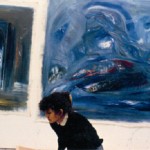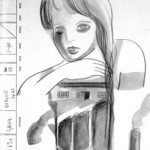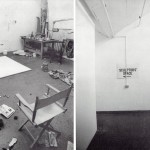Pilar Cossio, the constant nomad, always on the move with her water-colour paintings, drawings, notebooks, travelling from Fíorence to Turner’s London, the docks, Battersea Power Station, through Egypt and the deserts of Jordán, her native Santander, Naples, Sar-degna, a snowcovered New York, the both possible and impossible city of Madrid, to whioh she always returns eventually, filled with her own impressions and laden with her works.
In Italy, where she has spent most of her adult life, P. Cossio díscovered a classic enviromment, a reserve of myths, historie re-ferences used to inspire, not for repetitions but for constructing a contemporary work. In Italy she studied painting, first at the Finé Arts School of Rome and then in the School of Fíorence. Silvio Loffredo and Giancarlo Caldini have been the Florentain teachers from whom she has most learnt. C. Caldini a pupil of Rosai, as well as being a painter, as occurs with many artists of his country, is an outstanding writer, capable of reconstructing Daumier’s París or Mafai’s Rome. At presen!, during her free time, Pilar is translatmg Rosai’s correspondence, the author of such a mysterious Fíorence. She likes Italian paintings and the literatura of the ninteenth oentury. She enjoys the still-lifes an the landscapes of Filippo de Piséis and she also finds great pleausure in reading the prose of Romano Bilenchi and who amongst his «Friends» portrays Rosai, Pound, the Mar-quess of Villanova. She is algo interested in the «Macchiaioli», their feelings of landscapes, their ability for converting cotidian lifeinto art. Her two personal madrilenian exhibitions up to the present day have been clearly of a very marked Italian inspiration: «From the nomad to the Big Snail» (Gamarra Garrigues Gallery, 1985) and «In the salt-burnt lake» (Colegio del Rey Fondation, Alcalá de Henare, Madrid, 1986).
Whilst living and workíng from 1988-89 in London’s Delfina Studios, Pilar dedicated many hours contemplating «Oíd Father Thames» the now archaic industrial construc-tions along its banks, the boats, cranes, hangars, coal-bunkers, bridges, towers, the magnificient St. Paul’s Cathedral. The un-nerirng silhouette of Battersea Power Station with its four chimneys like columns in a great ruined temple, became a real obsesión for Pilar, as well as serving as an emblem deter-mining her London visions and fantasies, the centre of her recent work.
Pilar Cossio, a London -city stroller through the legendary fog and waters: She herself like «Alice» who sailed through the air and light of her paintings of London, between the morning mists, those past, stagnant waters, ¡n which the eternal dream of the Tate’s Ophelia, the mysterious painting which in-spired her ¡n 1986.
As well as her paintings, Pilar Cossio lived her stay in London from the moment of the before mentioned port landscape, she made innumerable jottins, very liberal drawings, light water-colours, cardboard and used en-velope «collages» ¡n which nows forms an important part of her memory.
I find that that London which Pilar Cossio interprets on her white canvas, ochre delcar-ton… reminds me of the London described by Fierre Mac Orlan in Impressions of the Thames (1925). Mac Orlan spoke there of the «Imperialist Poem» of the docks of London, which were then living their swan song. Thames Treasures «is the title of the strange picture by Pilar Cossio, bathed in underwater light, and overshadowed by the solid silhouette of a diving-suit, the attire, par ex-cellence, of scenken treasure seekers. Thames Treasures: delving inte the river of memory.
Whilst Pilar Cossio was painting her pic-tures of the Thames treasures, whilst she was jotting down notes of her sorroundings, she was dreaming, not only of the docks of the docks of that city which was then hers, and whose marvells and miserias she was day by day discovering, but also those of her native Santander.
By chance of a game of her poetio associ-ation, the soft, humid mountain landscapes emerged from her memory via her brush. The same part activity of the provincial capital returned. There carne a moment when she was uneware whether she was painting the Thames and the English landscape of the Cantabria.

Her last Spanish painting exibition took place last summer, ¡n Santander, incidentaly in a strongly connected marine building -The Pier Palace, which depends on the Port Works Council. Amongst the paintings exhi-bited one was not only very eloquently tittled «My Port».
In the end, and as always happens in art, the enviromment is none other than the leap-ing ground, the pretext. The surroundings of these fascinating port visions is neither of London ñor of Santander. It is a painted scene, the scene of Pilar Cossio’s dreams, a support to the spectator’s dream, of the inert traveller.
Its is a scene, more abstract than it appears to be at first siglit, a scene of far oft seas and emeralds, of rusty reds and of acid and electric yellows, an open scene, Through which Alíce sails, Ophelia, the factories, the coal-bunkers: docks memories.
Juan Manuel Bonet
Madrid. february 1992.
Traducción realizada por: Margaret Stembridge



